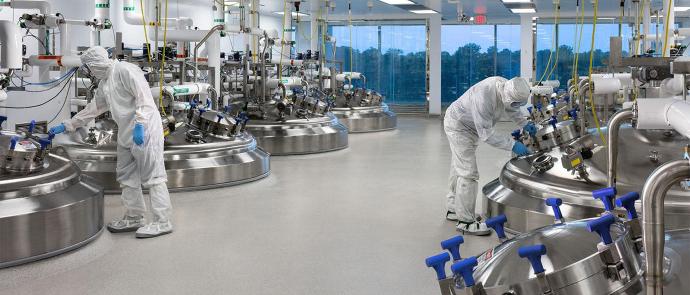
Laboratories
When selecting a floor for laboratories make sure to consider the specific requirements:
Durable protection, and ability to withstand frequent pedestrian and cart traffic. Slip resistance that provides the appropriate level of traction for a given area. An impermeable, smooth, non-absorbent surface with the ability to withstand exposure to chemicals in the room. Low maintenance, with easy and economical cleaning and sanitizing properties. Resistance to disinfectants and decontamination

Clean Rooms
A Clean room represent the most sensitive and technically demanding environment where hygiene is essential, such as in operating theatres, laboratories and pharmaceutical or electronics manufacturing. To prevent the spread of infection or the contamination of samples, pollutants like dust and airborne particles must be kept within strict limits. Clean rooms also need durable surfaces supporting heavy load equipment that are easy to maintain, resistant to chemicals and disinfectant and able to handle static electricity.


Airborne Particles
Ambient air contains millions of pollutant particles, from dust to microbes, which can cause infection or contamination during sensitive tasks like invasive surgery and preparing medication. That’s why the choice of materials and surfaces in clean rooms matters, contributing to the reduction of particles and preventing their spread.
Tarkett flooring meets ISO 3 and ISO 4 requirements, higher than ISO 5 as commonly specified for hospital operating theatres.

Indoor Air Quality
In a controlled, enclosed space where the airflow is managed to minimise external contact, indoor air quality takes on a new importance. Chemicals released by common materials like coatings and plastics must be strictly limited to maintain a safe, breathable atmosphere.
ISO 16000-6 defines how to analyse total volatile organic compounds (TVOCs) emitted by materials capable of degrading indoor air quality.
ISO 14644-8 classifies airborne molecular contamination (AMC) in terms of the atmospheric concentration of specific chemical substances in clean room air. This applies to products and processes that are sensitive to airborne contamination, such as in the healthcare, pharmaceutical and micro-electronic sectors.

GMP Facilities
Good Manufacturing Practice (GMP) is a set of guidelines and standards established by regulatory agencies, such as the Food and Drug Administration (FDA), to ensure that products are consistently produced and controlled according to quality and safety standards.
GMP guidelines apply to a wide range of industries, including pharmaceuticals, medical devices, food, and cosmetics.
Tarkett homogeneous vinyl flooring is certified as suitable floor covering for GMP Facilities.

High Resistance to Chemicals and Stains
Clean room areas should be easy to clean and disinfect, as well as impervious to fluids. Smooth flooring that is suitable for coving and forms perfectly sealed joints between wall and floor will help prevent the build-up of dirt and bacteria. Flooring and walls should also be resistant to chemical and detergents. Tarkett homogeneous vinyl floor covering is highly resistant to chemicals and intensive use of professional disinfectants.

ESD Protected Areas
Static electricity is generated by friction, such as from clothing or by shoes rubbing on the floor. Discharges may be painful, but more importantly they can damage sensitive equipment of the kind found in operating theatres, radiology rooms and pharmaceutical laboratories. This makes reducing the risk of electrostatic discharge a priority in clean rooms.
Flooring plays an important role by conducting electrical charges to a ground point. Conductive floor coverings have a lower electrical resistance and are often recommended for operating theatres where delicate surgery, such as cardiology or neurology, is performed. Dissipative floors have a higher resistance and conduct static more slowly, but they prevent discharge to and from human contact.
Tarkett has a wide range of ESD flooring collections for the most critical areas.